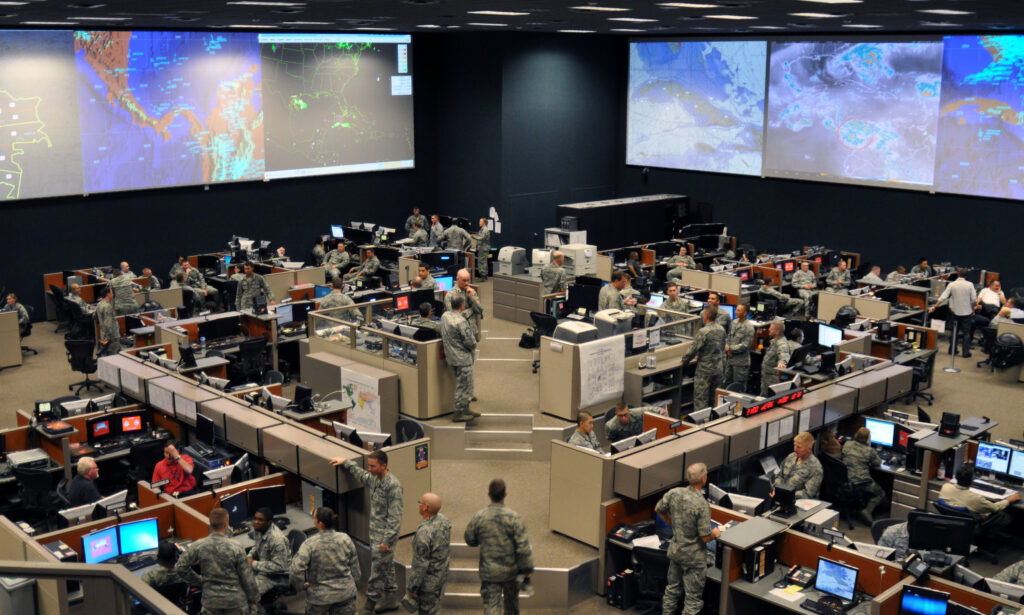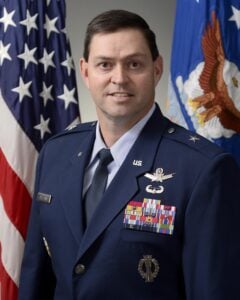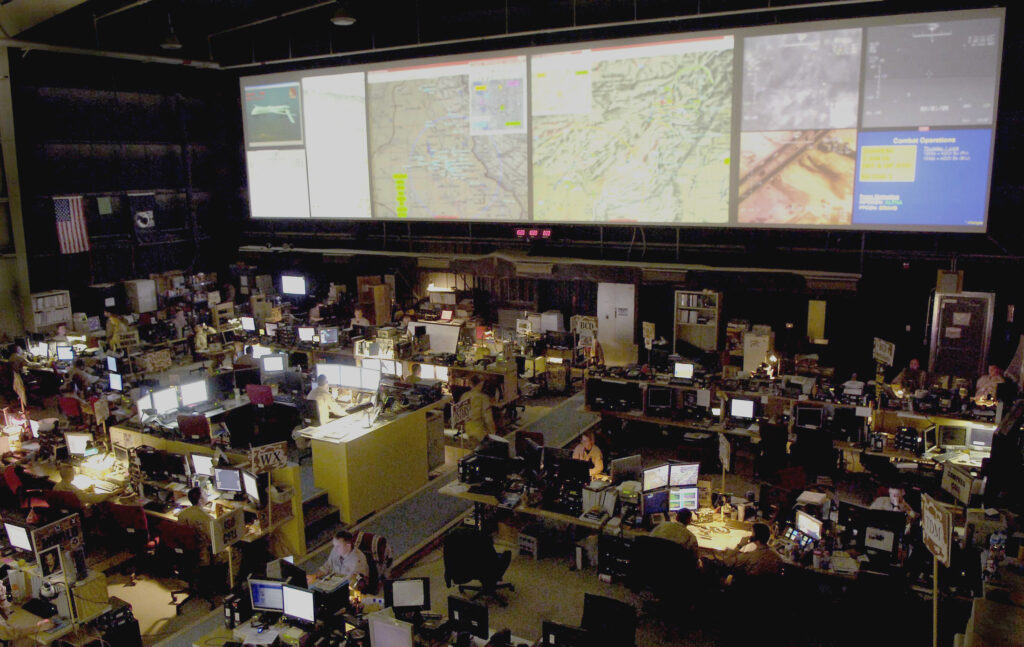‘Rolling The Marble:’ BG Saltzman On Air Force’s Multi-Domain C2 System
Posted on

The last generation of Command and Control, the Air Force Combined Air Operations Center
PENTAGON: In his first interview, the man overseeing the Air Force’s attempt to build the first truly global command and control system says it will demand major changes to the US military.
Multi-Domain Command & Control will demand changes to how America commands its troops around the world, to acquisition, to Air Force culture and its personnel system, and to the state of the art in military software.

Gen. Chance “Salty” Saltzman
It will even affect the current combatant commander (COCOM) construct, Brig. Gen. Chance “Salty” Saltzman told me: “We are going to have to relook at some basic principles going forward.”
Why? The brave new world of cyber war demands incredibly rapid analysis, recommendations and actions. It’ll probably be a decade before the US boasts a really effective means of visualizing cyber attacks on a global scale. Now add the need to make sense of war in space. Add air war. Add sea war. Add land war. Add a sprinkle of Saltzman, who’s been charged with getting the Air Force ready to build its Multi-Domain Command and Control system (MDC2).
“It’s all about algorithms. It’s about software making sense of it all for you,” Saltzman says. One of Bob Work’s last major initiatives as Deputy Defense Secretary was to launch a task force on “algorithmic warfare,” the use of artificial intelligence to make sense of masses of data. The ultimate goal, the holy grail, is what we call the War Algorithm: software that can sort through the complexities of modern war and show commanders the way to victory.
Guided by all this data, coordinated attacks will converge on the enemy from all domains — the land, sea, air, space, and cyberspace. “We want to put our enemy into as many dilemmas as possible,” Saltzman said.
The MDC2 team has done tabletop games to figure out how to integrate data from a huge array of sources, including civilian ones. The 505th Command and Control Wing at Hurlburt Field Air Force Base held what an official Air Force news story yesterday called “a ground-breaking exercise” July 17-21 with subject matter experts from around the world to help hammer out the “concept of multi-domain command and control.” And another major war game is in the works for 2018 to test concepts and help build initial goals for the system, Saltzman says.
Building, using and understanding a system this advanced will probably force the Air Force to create a speciality so that promising officers and enlisted can remain with MDC2 for much of their career, Saltzman believes: “We need to formalize and professionally develop a cadre for operational C2.” (They’d wear a black uniform with large feathered cap, he joked.) He’s still figuring out how best to do this.
The action plan — the first set of recommendations — on MDC2’s path ahead will be presented to Air Force Chief of Staff Gen. David Goldfein in November, Saltzman says.

Foreign liaison personnel in their cloistered section of Central Command’s Combined Air Operations Center (CAOC).
All Domains, All Services, All Allies, All Agencies
The Air Force and the other services face enormous obstacles as they begin building multi-domain command and control systems. They have to tap both the Intelligence Community and their own sensors, weapons and troops, fuse the information, and finally provide commanders around the world with actionable information they can use to confuse and defeat the enemy.
Complicating this is the need to pull that data from multiple domains (hence the name). The Air Force plans to incorporate data from space, air, sea and land around the globe and then to distribute that data to commanders wherever they need it. “If there’s a data source out there, I don’t want it to be excluded,” he says.
To that end, all four services are represented on the 130-strong MDC2 team, including an Army colonel and a Navy captain. There are also five foreign officers from Australia, Britain and Canada — all members of the Five Eyes nations that share top-level intelligence — to make sure that allied integration is as effective as possible. One of the team leads, Group Commander Blythe Crawford, is a British officer. Saltzman tells me he’s briefed the French military. Soon, the rest of NATO will be briefed.
To reach out beyond US and foreign militaries, Saltzman says he and his people are looking to the experience of the National Space Defense Center (formerly known as the JICPSOC), which combines all data from space assets of the Intelligence Community and the US military. Space warfare requires excellent sensor data and it needs to be gathered, analyzed and acted on in double-quick time, especially given the speed of cyber and electronic warfare attacks.
It’s not just militaries that need to get involved: It’s private industry as well. Since software development is central to building MDC2, Saltzman says the military needs to lower barriers to small companies so they have the same sort of access as large companies such as Google, Lockheed Martin and the other defense primes traditionally can claim.
They’re also creating what he calls a Shadow Ops Center — sort of an Apple Store — so that MDC2 evolves at the speed of commercial software instead of at the speed of the Pentagon’s traditional acquisition system. The ops center will be linked through nodes at Nellis, Langley, Hanscom, Wright-Patterson Air Force Bases and to the Pentagon’s DIUX centers. Another key to the speedier adoption of technology is DevOps, the approach to software development used by most Silicon Valley companies.
Add all this up and you’ve got what Gen. Ellen Pawlikowski, head of Air Force Materiel Command, calls agile acquisition. Pawlikowski leads the overall charge to build Penetrating Counter Air, MDC2 and future key Air Force weapon systems.

Former Defense Secretary Bill Perry
The Art of Making Marbles
One important point needs mentioning here. MDC2 is not going to be a weapon system so much as a process for putting one together and keeping it useful. Saltzman says he wants to put the “machinery in place to make marbles; not just provide the chief with some marbles.” This is a reference to a famous meeting where Lockheed Martin’s Ben Rich sat down with then Defense Secretary Bill Perry, took a marble out of his pocket and put it on the table to illustrate how small
This is how Goldfein described what happened next at this year’s February AFA meeting in Orlando: “He rolled it across the table. Secretary Perry said “what’s that?” He said ‘that’s the radar cross section I’m about to build you’ And the rest, as they say, is history. So what’s the moral of the story?….We’ve got to be the organization that accepts the marble, and acts on it. And for industry, the marble I’m asking you to roll our way is getting at Multi-Domain Command and Control.”
MDC2, PCA (Penetrating Counter-Air), PEW (Penetrating Electronic Warfare) and the OA-X close air support plane are the first projects started as part of the service’s Strategic Development Planning Experimentation, which Pawlikowksi oversees. (We’ll see the flyoff for OA-X at Holloman Air Force Base on Wednesday.)
The small team that leads the SDPE brings in intelligence experts and technologists to work out concepts of operations for the prospective capability. They then bring in warfighters to have a look. They run war games to test it. They go back and tear the initial concepts apart, then keep pressing to make sure they come up with a blend of technologies and capabilities that should be able to stand the test of time and meet predicted threats come 2030.
Once a concept is identified as a capability gap, the Air Force then creates an Enterprise Capability Collaboration Team (ECCT) to examine the best ways to fill the gap. This is exactly what Saltzman and his team are doing today.
Subscribe to our newsletter
Promotions, new products and sales. Directly to your inbox.
